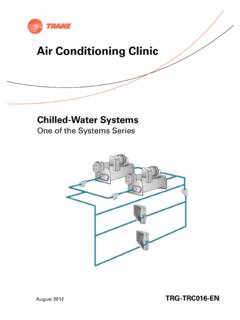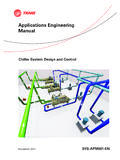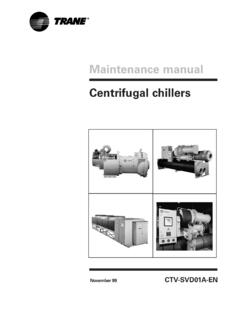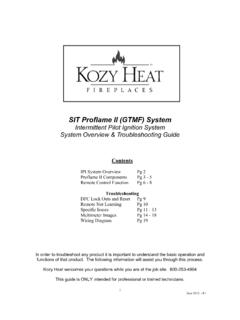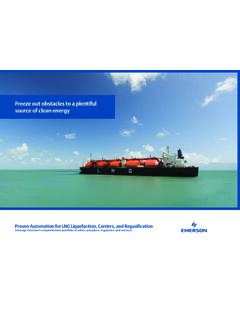Transcription of One of the Fundamental Series - Trane
1 June 2011 TRG-TRC006-ENAir Conditioning ClinicRefrigerant PipingOne of the Fundamental Series Refrigerant PipingOne of the Fundamental SeriesA publication of TranePreface 2011 Trane All rights reservedTRG-TRC006-ENiiTrane believes that it is incumbent on manufacturers to serve the industry by regularly disseminating information gathered through laboratory research, testing programs, and field Trane Air Conditioning Clinic Series is one means of knowledge sharing. It is intended to acquaint a technical audience with various Fundamental aspects of heating, ventilating, and air conditioning (HVAC). We have taken special care to make the clinic as uncommercial and straightforward as possible. Illustrations of Trane products only appear in cases where they help convey the message contained in the accompanying particular clinic introduces the reader to refrigerant PipingA Trane Air Conditioning ClinicFigure 1 TRG-TRC006-ENiiiContentsperiod oneRefrigerant Piping Requirements.
2 1period twoSuction Line .. 10 Requirements for Sizing and Routing .. 10 Sizing Process .. 12 Other Considerations .. 24period threeDischarge Line .. 31 Requirements for Sizing and Routing .. 31 Sizing Process .. 33 Other Considerations .. 39period fourLiquid Line .. 41 Requirements for Sizing and Routing .. 41 Sizing Process .. 45 Other Considerations .. 57period fiveHot-Gas Bypass Line .. 60 Hot-Gas Bypass to Evaporator Inlet .. 62 Hot-Gas Bypass to the Suction Line .. 66 Other Considerations .. 68period sixReview .. 70 Quiz .. 76 Answers .. 78 Glossary .. 79ivTRG-TRC006-ENTRG-TRC006-EN1notesperi od oneRefrigerant Piping RequirementsThe focus of this clinic is on the design and installation of the interconnecting piping for vapor-compression refrigeration systems.
3 Reviewing the physical changes that the refrigerant undergoes within the refrigeration cycle will help demonstrate certain demands that the piping design must clinic focuses on systems that use Refrigerant-22 (R-22). While the general requirements are the same for systems that use other refrigerants, velocities and pressure drops will 3 illustrates a basic vapor-compression refrigeration cycle. Refrigerant enters the evaporator in the form of a cool, low- pressure mixture of liquid and vapor (A). Heat is transferred to the refrigerant from the relatively warm air that is being cooled, causing the liquid refrigerant to boil. The resulting refrigerant vapor (B) is then pumped from the evaporator by the compressor, which increases the pressure and temperature of the oneRefrigerant Piping RequirementsRefrigerant PipingFigure 2 Vapor-Compression Refrigerationexpansionexpansiondevicedev icecondensercondensercompressorcompresso revaporatorevaporatorABCDF igure 32 TRG-TRC006-ENnotesperiod oneRefrigerant Piping RequirementsThe resulting hot, high- pressure refrigerant vapor (C) enters the condenser where heat is transferred to ambient air, which is at a lower temperature than the refrigerant.
4 Inside the condenser, the refrigerant vapor condenses into a liquid and is subcooled. This liquid refrigerant (D) then flows from the condenser to the expansion device. This device creates a pressure drop that reduces the pressure of the refrigerant to that of the evaporator. At this low pressure , a small portion of the refrigerant boils (or flashes), cooling the remaining liquid refrigerant to the desired evaporator temperature. The cool mixture of liquid and vapor refrigerant (A) enters the evaporator to repeat the vapor-compression refrigeration cycle, and the four major components of the refrigeration system (evaporator, compressor, condenser, and expansion device), are discussed in more detail in separate clinics. Refer to the list of references at the end of Period individual components are connected by refrigerant piping.
5 The suction line connects the evaporator to the compressor, the discharge line connects the compressor to the condenser, and the liquid line connects the condenser to the expansion device. The expansion device is typically located at the end of the liquid line, at the inlet to the is more to the design of refrigerant piping than moving refrigerant from one component to another. Regardless of the care exercised in selection and application of the components of the refrigeration system, operational problems may be encountered if the interconnecting piping is improperly designed or Refrigerant Pipingcompressorcompressorcondenserconde nserevaporatorevaporatorexpansion expansion devicedevicedischargedischargelinelinesu ctionsuctionlinelineliquidliquidlineline ABCDF igure 4 TRG-TRC006-EN3period oneRefrigerant Piping RequirementsnotesWhen a refrigeration system includes field-assembled refrigerant piping to connect two or more of the components, the primary design goals are generally to maximize system reliability and minimize installed cost.
6 To accomplish these two goals, the design of the interconnecting refrigerant piping must meet the following requirements: Return oil to the compressor at the proper rate, at all operating conditions Ensure that only liquid refrigerant (no vapor) enters the expansion device Minimize system capacity loss that is caused by pressure drop through the piping and accessories Minimize the total refrigerant charge in the system to improve reliability and minimize installed costThe first requirement is to ensure that oil is returned to the compressor at all Refrigerant Piping RequirementsVReturn oil to compressorVEnsure that only liquid refrigerant enters the expansion deviceVMinimize system capacity lossVMinimize refrigerant chargeFigure 5 Scroll Compressorstationarystationaryscrollscro lldrivendrivenscrollscrollintakeintakedi schargedischargeintakeintakedischargedis chargeportportmotormotorshaftshaftsealse alFigure 64 TRG-TRC006-ENnotesperiod oneRefrigerant Piping
7 Requirementsoperating conditions. Oil is used to lubricate and seal the moving parts of a compressor. For example, the scroll compressor shown in Figure 6 on page 3 uses two scroll configurations, mated face-to-face, to compress the refrigerant vapor. The tips of these scrolls are fitted with seals that, along with a thin layer of oil, prevent the compressed refrigerant vapor from escaping through the mating surfaces. Similarly, other types of compressors also rely on oil for lubrication and for providing a seal when compressing the refrigerant , some of this lubricating oil is pumped along with the refrigerant throughout the rest of the system. While this oil has no function anywhere else in the system, the refrigerant piping must be designed and installed so that this oil returns to the compressor at the proper rate, at all operating to the system schematic, droplets of oil are pumped out of the compressor along with the hot, high- pressure refrigerant vapor.
8 The velocity of the refrigerant inside the discharge line must be high enough to carry the small oil droplets through the pipe to the the condenser, the refrigerant vapor condenses into a liquid. Liquid refrigerant and oil have an affinity for each other, so the oil easily moves along with the liquid refrigerant. From the condenser, this mixture of liquid refrigerant and oil flows through the liquid line to the expansion , the refrigerant oil mixture is metered through the expansion device into the evaporator, where the liquid refrigerant absorbs heat and vaporizes. Again, the velocity of the refrigerant vapor inside the suction line must be high enough to carry the droplets of oil through the pipe back to the adequate velocity and proper pipe installation, oil may be trapped out in the system.
9 If this condition is severe enough, the reduced oil level in the compressor could cause lubrication problems and, potentially, mechanical Oil to Compressorscompressorcompressorcondenser condenserevaporatorevaporatorexpansion expansion devicedevicedischargedischargelinelinesu ctionsuctionlinelineliquidliquidlineline warmwarmliquidliquidhothotvaporvaporcool coolvaporvaporFigure 7 TRG-TRC006-EN5period oneRefrigerant Piping RequirementsnotesThe second requirement of the refrigerant piping design is to ensure that only liquid refrigerant enters the expansion device. There are several types of expansion devices, including expansion valves (thermostatic or electronic), capillary tubes, and addition to maintaining the pressure difference between the high- pressure (condenser) and low- pressure (evaporator) sides of the system, a thermostatic expansion valve (TXV) also controls the quantity of liquid refrigerant that enters the evaporator.
10 This ensures that the refrigerant will be completely vaporized within the evaporator, and maintains the proper amount of superheat in the the condenser, after all of the refrigerant vapor has condensed into liquid, the refrigerant is subcooled to further lower its temperature. This subcooled liquid refrigerant leaves the condenser (A) and experiences a pressure drop as it flows through the liquid line and accessories, such as a filter Thermostatic Expansion Valve (TXV)external equalizerexternal equalizerremote remote bulbbulbevaporatorevaporatorTXVTXV refrigerantrefrigerantvaporvapordistribu tordistributorliquid liquid refrigerantrefrigerantFigure 8 SubcoolingBApressurepressureenthalpyenth alpy{subcoolingsubcoolingCmixture of liquid mixture of liquid and vaporand vaporsaturatedsaturatedvapor curvevapor curvesaturatedsaturatedliquid curveliquid curveexpansionexpansiondevicedeviceconde nsercondenserevaporatorevaporatorcompres sorcompressorFigure 96 TRG-TRC006-ENnotesperiod oneRefrigerant Piping Requirementsdrier and solenoid valve, installed upstream of the TXV.}
